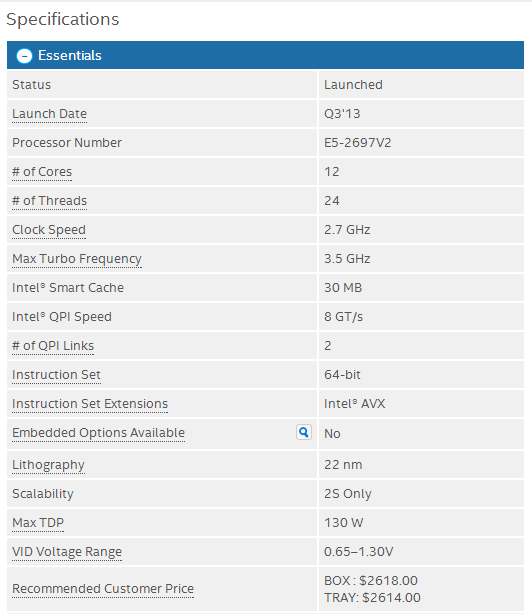Intel Xeon E5-2697 v2 “Ivy Bridge-EP” Processor Review
Ryan Martin / 10 years ago
Introduction

When it comes to x86 processors of pure unadulterated power Intel’s high-end Xeon platforms are the only way to go. Intel’s “EP” (Efficient Performance) SKUs are often some of the most impressive processors that come to market sitting between the high-end consumer and small business segments. Over the years we’ve seen the EP series processors grow in core count as Intel’s CPU architectures have become more efficient in terms of power consumption, thermal specifications and their general design. For example, Westmere-EP had up to 6 cores, Sandy Bridge-EP had up to 8 cores and this current Ivy Bridge-EP series has up to 12 cores. Today we are reviewing the flagship processor of the Ivy Bridge-EP series, the Intel Xeon E5-2697 v2 processor. Thanks to Intel’s generosity we have the opportunity to test a pair of these monstrous CPUs. On paper these are the most powerful CPUs available on the market within that top-end consumer bracket: these CPUs will work with all consumer hardware such as “normal” graphics cards, unbuffered non-ECC RAM, consumer operating systems like Windows 7 and so on. Yet with 12 cores, 24 threads and a 130W TDP its a heck of a lot of performance for any consumer so Intel’s main target is working professionals, small and medium size businesses and anyone who needs a serious amount of x86 computing power. However, the term reasonable cannot be used for the pricing as Intel expects consumers or businesses using these Xeon chips to pay a pretty penny – $2618 to be exact. That said you get what you pay for: with 12 cores and 24 threads in an efficient 130W package Intel’s Xeon E5-2697 v2 is unmatched by any other current generation hardware. Of course Intel’s Haswell-EP is just around the corner and with that we should expect the core limit to be increased again to a staggering 16 cores (if rumours are to be believed) within similar thermal envelopes, we will also see the jump to DDR4 memory made so Ivy Bridge-EP will be the last DDR3 EP platform from Intel.
Below you can find Intel’s key specifications of the E5-2697 v2 processor, you can get more detailed specifications on the product page here if you so desire. In today’s review we will be testing this CPU in single and dual configurations and putting it up against the Sandy Bridge-EP flagship the Xeon E5-2670. Sadly, we only have one of these for testing since one of them passed away (RIP!), please consider that before commenting on why dual E5-2670 CPUs were not included in the results – we wanted them to be but it simply wasn’t possible. Given the prosumer/business orientation of these products we’ve tried to use more productivity related benchmarks. If there are any relevant benchmarks readers think are missing then please feel free to inform us your thoughts in the comments so we can improve future Xeon processor reviews. In a pre-emptive statement I would also like to clarify that the gaming benchmarks are there not because I see these CPUs as being relevant for gaming, but because we ALWAYS get LOTS of questions about how these CPUs perform in games. Anyway…enough rambling let’s proceed to look at some testing results!




















